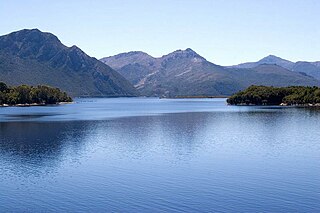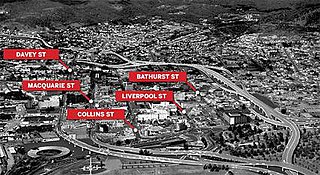
kunanyi/Mount Wellington is a dominant feature on the skyline above Hobart, in Tasmania, Australia.
Contents
An aerial cableway (cable car) from Hobart to the peak of the mountain, has been proposed for the mountain on four occasions.

kunanyi/Mount Wellington is a dominant feature on the skyline above Hobart, in Tasmania, Australia.
An aerial cableway (cable car) from Hobart to the peak of the mountain, has been proposed for the mountain on four occasions.
The first two of these pre-dated the construction of Pinnacle Road. In 1905, Arnold Wertheimer proposed the construction of an aerial cableway (at the time referred to as an "aerial railway") from The Springs to the Pinnacle of Mt Wellington, [1] [2] and in 1906 established The Mount Wellington Aerial Railway Company Ltd. [3] This proposal was soon modified to run from Cascades to the pinnacle, [4] but in the end never eventuated.
The concept was shelved until 1931, when an Aerial Tramway proposal involving a nine-minute journey from The Springs to the pinnacle was publicised. [5] Included in this was a kiosk and observation deck, as well as the potential to provide for skiing on the slopes at the rear of the mountain.
After construction of Pinnacle Road was completed in 1937, momentum for an aerial cableway slowed. While general access to the pinnacle was easily available, justification for later cableway developments included the inability to access the pinnacle on periods of high snowfall; [6] the growth of Tasmania as a tourism destination; [6] and, since the increase of climate change awareness in the later parts of the 20th century, the environmental impact of motor vehicle pollution.[ citation needed ]
The next proposal did not come forward until 1987, when the first of three proposals by Hobart engineer Tim Burbury was announced. The 1987 proposal, by Burbury's company Trinity Projects, was to feature a hotel on the pinnacle serviced by a cable car based at Fern Tree. The public opposition was high enough that the plan was dropped before it went into detailed design. [7] In 1993, Burbury relaunched a modified proposal, estimated to cost A$31 million, known as Skyway. It featured a change of base location, to a hill near Cascade Brewery, and used two high capacity carriages to transport passengers. [8] At the pinnacle, the hotel proposal was dumped for a restaurant, and added a ski field at the rear of the mountain. Again, there was strong public opposition to this plan – including a reduction of privacy of residents near the lower part of the cable car, and destruction of the natural alpine environment. [7] The third revision of Burbury's plan was announced in 2004, including an alternate route, change from a large carriage to a series of smaller gondolas, a modified pinnacle centre design and removal of the ski field component of the project. [8] [9]
After Burbury's death in 2010, Hobart businessman and entrepreneur Adrian Bold took on a renewed focus to develop a cable car for Mt Wellington. Several years of advocacy, feasibility assessment and preliminary design, culminated in a formal launch on 16 April 2014 of a two-part route from Cascade Brewery to a pinnacle centre at the summit, including a restaurant, café and function centre. [10] [11] The proponent's partner, Toronto-based company BullWheel International, announced in November 2015, that it no longer had any involvement with the cable car proposal. [12]
The issue continued to be in public discussion over the years. [13] [14] [15]
The planning and construction of a cable car has been beset by a range of issues, Including environmental, Aboriginal cultural heritage and aesthetic concerns. [16] [17]
The cable car proposal remains a divisive issue with opposition to the idea being led by a South Hobart based group. [18] A number of social media groups have been established both for and against the concept.
On 10 August 2018 a Hobart City Council committee voted against allowing the allocation of public lands for the project [19] and on 27 July 2021 the full council voted against the project. [20] [21]
The proposal's proponents plan lost an appeal, with Tasmania's planning authority ruling it failed to satisfy standards around noise, visual impact and biodiversity. [22]
{{citation}}: |last= has generic name (help)
Hobart is the capital and most populous city of the Australian island state of Tasmania. Home to almost half of all Tasmanians, it is the least-populated Australian state capital city, and second-smallest if territories are taken into account, before Darwin, Northern Territory. Hobart is located in Tasmania's south-east on the estuary of the River Derwent, making it the most southern of Australia's capital cities. Its skyline is dominated by the 1,271-metre (4,170 ft) kunanyi/Mount Wellington, and its harbour forms the second-deepest natural port in the world, with much of the city's waterfront consisting of reclaimed land. The metropolitan area is often referred to as Greater Hobart, to differentiate it from the City of Hobart, one of the five local government areas that cover the city. It has a mild maritime climate.

The River Derwent is a river located in Tasmania, Australia. It is also known by the palawa kani name timtumili minanya. The river rises in the state's Central Highlands at Lake St Clair, and descends more than 700 metres (2,300 ft) over a distance of more than 200 kilometres (120 mi), flowing through Hobart, the state's capital city, before emptying into Storm Bay and flowing into the Tasman Sea. The banks of the Derwent were once covered by forests and occupied by Aboriginal Tasmanians. European settlers farmed the area and during the 20th century many dams were built on its tributaries for the generation of hydro-electricity.

Mount Wellington ) is a mountain in the southeast of Tasmania, Australia. It is the summit of the Wellington Range and is within Wellington Park reserve. Hobart, Tasmania's capital city, is located at the foot of the mountain.

South Hobart is one of Hobart's inner suburbs. It is bound by Dynnyrne, Fern Tree, West Hobart and the Hobart City Centre.

Mount Owen is a mountain directly east of the town of Queenstown on the West Coast Range in Western Tasmania, Australia.

Mount Huxley is a mountain located on the West Coast Range in the West Coast region of Tasmania, Australia. With an elevation of 926 metres (3,038 ft) above sea level, the mountain was named by Charles Gould in 1863 in honour of Professor Thomas Henry Huxley.

Triple M Hobart is part of the Southern Cross Austereo network of Triple M Network radio stations, Based in Hobart, Tasmania, Australia.

ABT is a television station operated by the publicly-owned Australian Broadcasting Corporation, with a transmission area covering southern Tasmania. ABT began broadcasting on VHF channel 2 on 4 June 1960, with studios in inner-city Hobart and transmitter at Mount Wellington. The "AB" in the call sign stands for "Australian Broadcasting", as in Australian Broadcasting Commission. The "T" in the call sign stands for Tasmania.

Elwick Racecourse is a Thoroughbred horse-racing venue located on Goodwood Road within Glenorchy, Tasmania, Australia. It is located in close proximity to the Brooker Highway, Hobart Showground, Derwent Entertainment Centre, Glenorchy Art and Sculpture Park and the River Derwent. The Racecourse has a picturesque outlook across the river, as well as being dominated by views of kunanyi/Mount Wellington. Elwick features at least 110 race meetings and 210 trial days a year, but is most well known for hosting the Hobart Cup.

The Wellington Range is a mountain range located in the southeast region of Tasmania, Australia. The range is mainly composed of dolerite and features evidence of past glaciation.
Evelyn Temple Emmett (1871–1970) was the first Director of the Tasmanian Government Tourist Bureau and a founder of the Hobart Walking Club He actively promoted skiing and bushwalking in the state and served on several National Park boards. Several Tasmanian features are named after him.

Trams no longer operate in Hobart, the capital of the Australian state of Tasmania, but the city once had an extensive and popular system that reached the majority of its suburbs. It was the first complete electric tram system in the Southern Hemisphere, and the only one in Australia to operate double-decker trams.

The Hobart Bypass is a proposed concept to bypass the Central Business District of Hobart, Tasmania. Currently, through traffic travels from the Tasman/Brooker Highways down the one-way Davey/Macquarie couplet to the Southern Outlet. As well as traffic concerns, there is also a call to build the bypass on the grounds that the current traffic arrangement cuts the central business district off from Hobart's waterfront.
The Glover Prize is an Australian annual art prize awarded for paintings of the landscape of Tasmania The prize was inaugurated in 2004 by the John Glover Society, based in Evandale, Tasmania, in honour of the work of British-born landscape painter John Glover, who lived and painted in the area from 1832 until his death in 1849. The current prize amount of A$ 50,000 is the highest for landscape painting in Australia. The 2012 award was controversial: the winning picture included a depiction of convicted Port Arthur massacre spree killer Martin Bryant in the landscape of Port Arthur.
The Mount Roland cable car is a proposed aerial lift at Mount Roland, near Sheffield, Tasmania, Australia.

Wellington Park is the protected area which encompasses kunanyi / Mount Wellington and surrounds near Hobart, Tasmania. There are numerous hiking and mountain bike tracks within the park of varying difficulty.
Wellington Park is a rural locality in the local government areas of Derwent Valley, Hobart, Glenorchy, Huon Valley, and Kingborough in the South-east and Hobart regions of Tasmania. It is located about 20 kilometres (12 mi) west of the Hobart CBD. The 2016 census determined a population of nil for the state suburb of Wellington Park.